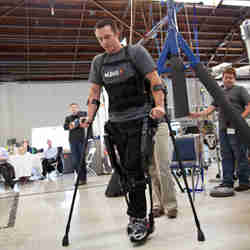
One of this summer’s blockbuster movies features humans controlling giant mechanical bodies to do battle against Godzilla-like monsters. Pacific Rim is just the latest installment in a long history of science fiction movies featuring exosuits: these include Tony Stark in the Iron Man series, and few fans can forget the one worn by Sigourney Weaver as Ripley to fight the queen in Aliens back in 1986.
Such body-assisting machines are no longer confined to the realm of science fiction; nor are they only for kicking alien butt. Several companies in the U.S. and overseas have been working on developing exoskeletons for Earthbound uses for years.
According to Russ Angold, chief technology officer of Ekso Bionics in Richmond, CA, the chief drivers of exoskeleton development are the military and the medical sector. "Military and medicine are the two ends of the spectrum—the ‘killer apps’ where there is the highest value proposition," says Angold. "But there will be consumer and industrial applications."
Military applications
It’s no mystery why the military would be interested in exoskeletons. Soldiers must traverse varying terrain—currently including deserts and mountains—while carrying heavy loads. That can lead to back strain and other injuries. Addressing these issues is the idea behind Lockheed Martin’s Human Universal Load Carrier (HULC), developed under license from Ekso Bionics. The hydraulic-powered HULC is primarily a lower-body exoskeleton, with power supplied at the knee and hip joints, designed to facilitate rapid movement.
The HULC enables a soldier to carry up to 200 pounds for longer periods of time and over longer distances than he/she normally could, as the machine’s frame supports the bulk of the weight. Lockheed has also designed attachments that enable a soldier to singlehandedly lift weights that would normally require multiple men to move.
Lockheed’s original HULC prototype entered testing in the summer of 2010, but its batteries didn’t last long enough in the field. Last year, however, a Lockheed representative told Wired that a newer version could march for eight hours and that its batteries could last for days on standby.
For a time, Raytheon was also working on an exoskeleton for military use, called the XOS. The XOS was originally developed by robotics company Sarcos, which Raytheon purchased in 2007. Work on the XOS has ceased, however, because its potential customer no longer has funding for the project.
Medical applications
Ekso Bionics’ exoskeleton primarily focuses on the medical end of the spectrum. The company’s product, called the Ekso, is designed to enable patients whose legs are fully or partially paralyzed by spinal cord injuries, multiple sclerosis, amyotrophic lateral sclerosis (Lou Gehrig’s disease), Parkinson’s, or other conditions, to walk using the suit and a set of crutches.
The Ekso is designed for use under medical supervision, for training and exercise. In the first stage of training, the patient uses the suit to stand with a walker or crutches, and the therapist initiates the walking motion by pushing buttons. The training progresses through increasing user control until, in the final stage, the suit responds to shifts in the wearer’s weight.
Ekso’s exoskeleton already is deployed at 21 hospitals and rehabilitation centers across the United States, with eight more in Europe and one in South Africa. The company sees that as only the first wave of deployment; "As we get better at building them and start driving costs down," says Angold, "we could see them on Home Depot workers with back injuries," or protecting those workers from incurring such injuries in the first place.
A similar approach comes from Argo Medical Technologies, founded by a paraplegic in 2001. Argo’s ReWalk Rehabilitation exoskeleton won U.S. Food and Drug Administration (FDA) approval in 2011; like the Ekso, it’s designed for use in rehabilitation centers for exercise and therapy. The company is awaiting FDA approval for its ReWalk Personal (already in use in Europe), intended for use by people otherwise bound to wheelchairs; it is a lower-body assistive device and requires the user to be able to use crutches.
Commercial applications
Angold’s Home Depot scenario is a good example of the possible non-military and non-medical tasks that protection combined with extra power could help with. (Remember, Ripley’s fighting suit in Aliens was actually a power loader.)
The Japanese company Cyberdyne is designing its Robot Suit HAL (for "hybrid assistive limb") to support those with disabilities, but also for more general purposes. HAL looks like vaguely like a white plastic Iron Man suit and comes in two varieties, one for just the lower limbs and one for the entire body. It works by detecting nerve signals in the wearer’s skin to understand the intended motion. That system is integrated with an autonomous robotic system; hence, the "hybrid" in its name.
Cyberdyne makes Robot Suit HAL available for rent in Japan; as of last fall, more than 300 suits were available at 130 rehabilitation centers across the country. The company also promotes HAL for use in emergency situations, such as clearing rubble and extracting victims at a disaster site. In November 2011, the company offered a version of Robot Suit HAL to cleanup workers at the Fukushima nuclear plant; the suit, worn under the anti-radiation outfits the workers wore, would enable them to support the weight of the outfits and work longer without tiring.
Next steps
In 2010, ABI Research predicted a compound annual growth rate for the "human augmentation system" market of 41 percent through 2020, with revenues of $877 million by that year. Requirements for the industry to meet that goal include further improvements in power supplies, batteries and overall efficiency.
"The interesting thing about exoskeletons is that they are not plugged in," says Angold. "Since we are a mobile application, exoskeletons will always have a power problem." As a result, a lot of work is being aimed at making their power sources more compact, efficient, and longer lasting.
In addition, researchers are working on improving what Angold calls "transparency" to the user. "What we’re focusing on now is innovative control strategies," he says. The idea is to get rid of levers and buttons and let the user operate the suit "naturally," through such mechanisms as Robot Suit HAL’s skin sensors or the Ekso’s weight sensors.
With better power sources and more intuitive control systems, it might not be long before exoskeletons move from the battlefield and hospital to the workplace and living room.
Logan Kugler is a freelance technology writer based in Silicon Valley. He has written for more than 60 major publications.



Join the Discussion (0)
Become a Member or Sign In to Post a Comment